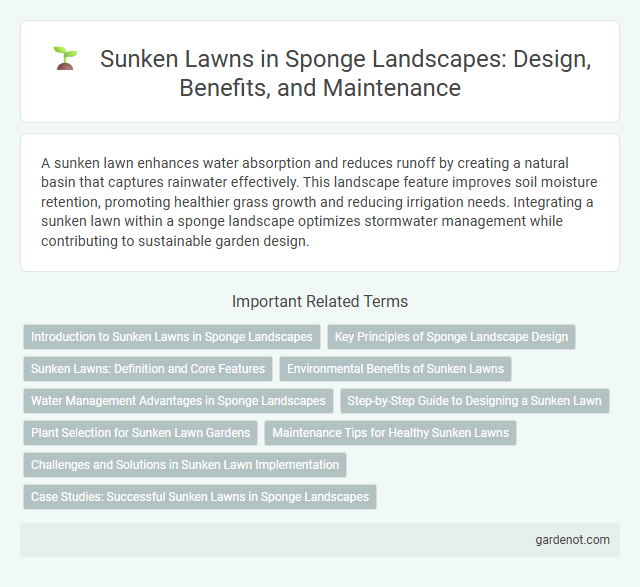A sunken lawn enhances water absorption and reduces runoff by creating a natural basin that captures rainwater effectively. This landscape feature improves soil moisture retention, promoting healthier grass growth and reducing irrigation needs. Integrating a sunken lawn within a sponge landscape optimizes stormwater management while contributing to sustainable garden design.
Introduction to Sunken Lawns in Sponge Landscapes
Sunken lawns are a distinctive feature in sponge landscapes, designed to enhance water retention and manage stormwater effectively. These depressed grassy areas collect runoff, allowing natural infiltration and reducing surface flooding while supporting healthy turf growth. Integrating sunken lawns into sponge landscapes optimizes urban water management and promotes sustainable green infrastructure.
Key Principles of Sponge Landscape Design
Sunken lawns are integral to sponge landscape design, effectively managing rainwater by capturing and slowly infiltrating runoff into the soil. Key principles include creating depressions at strategic locations to maximize water retention, using permeable soil layers to enhance absorption, and integrating native vegetation that supports soil stability and water filtration. This approach reduces urban flooding, replenishes groundwater, and promotes ecological balance within urban environments.
Sunken Lawns: Definition and Core Features
Sunken lawns are recessed garden areas designed to collect and manage stormwater naturally, enhancing water absorption and minimizing runoff. Key features include a gently lowered surface relative to surrounding terrain, permeable soil layers for optimal infiltration, and strategic landscaping with native plants to support ecosystem balance. These sustainable spaces serve as effective urban drainage solutions while creating aesthetically appealing green zones.
Environmental Benefits of Sunken Lawns
Sunken lawns significantly enhance stormwater management by capturing and infiltrating rainwater, reducing runoff and minimizing soil erosion. These depressions promote groundwater recharge, supporting local water tables and improving urban resilience against flooding. Their vegetation also aids in filtering pollutants, contributing to cleaner surrounding ecosystems and increased biodiversity.
Water Management Advantages in Sponge Landscapes
Sunken lawns in sponge landscapes enhance water management by capturing and retaining rainwater, reducing surface runoff and minimizing flood risks. Their design facilitates natural infiltration, replenishing groundwater and improving soil moisture levels for healthier vegetation growth. This sustainable approach promotes efficient stormwater control, mitigating urban heat island effects and supporting resilient urban ecosystems.
Step-by-Step Guide to Designing a Sunken Lawn
Designing a sunken lawn involves excavating the desired area to create a lowered surface that enhances drainage and visual interest. Begin by assessing soil type and slope, then install proper drainage systems such as French drains to prevent water accumulation. Finish by grading the soil evenly, planting resilient turf grass, and adding retaining walls or edging to define the sunken space and prevent erosion.
Plant Selection for Sunken Lawn Gardens
Choosing drought-tolerant plants such as ornamental grasses, sedges, and native wildflowers enhances water absorption in sunken lawn gardens. Deep-rooted perennials like Black-eyed Susans and Purple Coneflowers improve soil structure and reduce runoff by stabilizing the soil. Incorporating moisture-loving plants such as ferns and hostas in lower areas supports biodiversity and resilience in sponge landscape designs.
Maintenance Tips for Healthy Sunken Lawns
Regular aeration and proper drainage are essential for maintaining a healthy sunken lawn, preventing water accumulation and root rot. Applying a balanced fertilizer during the growing season promotes strong grass growth and resilience. Monitoring soil moisture and adjusting irrigation ensures the lawn receives adequate hydration without overwatering, supporting a lush, vibrant landscape.
Challenges and Solutions in Sunken Lawn Implementation
Sunken lawn implementation faces challenges such as water drainage issues, soil stability problems, and uneven surface maintenance. Effective solutions include installing proper drainage systems like French drains, reinforcing the soil with techniques such as soil compaction and geotextile fabrics, and regular leveling to prevent pooling and erosion. Incorporating native drought-resistant grass varieties also enhances lawn resilience and reduces maintenance needs in sunken landscapes.
Case Studies: Successful Sunken Lawns in Sponge Landscapes
Case studies of successful sunken lawns in sponge landscapes demonstrate enhanced stormwater management and increased groundwater recharge. These projects utilize depressions strategically integrated into urban green spaces to collect and infiltrate runoff, reducing flooding risks and improving soil moisture retention. Notable examples include Chengdu's Tianfu Ecological Park and Singapore's Bishan-Ang Mo Kio Park, where sunken lawns contribute to sustainable urban drainage systems and biodiversity support.
Sunken lawn Infographic

 gardenot.com
gardenot.com